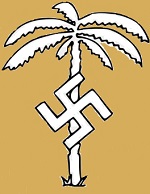Hobby Master HG1702 German Sd. Kfz. 2 NSU Kettenkrad Light Tractor - Ramcke Parachute Brigade, Deutsches Afrika Korps, North Africa, 1942 (1:48 Scale)
"If the tank succeeds, then victory follows."
- Major-General Heinz Guderian, "Achtung Panzer!"
 Featuring three forward and one reverse gear, the Kettenkrad was used in a variety of roles including a transportation vehicle, power generator, communications vehicle, and towing vehicle. Capable of towing up to 4-tons it was widely used to pull light artillery and other equipment, as well as aircraft when used by the Luftwaffe.
Featuring three forward and one reverse gear, the Kettenkrad was used in a variety of roles including a transportation vehicle, power generator, communications vehicle, and towing vehicle. Capable of towing up to 4-tons it was widely used to pull light artillery and other equipment, as well as aircraft when used by the Luftwaffe.
The Goliath tracked mine (complete name: Leichter Ladungstrager Goliath (Sd.Kfz. 302/303a/303b)) was a remote controlled German-engineered demolition vehicle, also known as the beetle tank to Allies. Employed by the Wehrmacht during World War II, this caterpillar-tracked vehicle was approximately four feet long, two wide, and one tall. It carried 75-100 kg (165-220 lb) of high explosives and was intended to be used for multiple purposes, such as destroying tanks, disrupting dense infantry formations, and demolition of buildings and bridges.
Pictured here is a 1:48 scale replica of a German Sd. Kfz. 2 NSU Kettenkrad light tractor that was attached to the Ramcke Parachute Brigade, Deutsches Afrika Korps, then deployed to North Africa during 1942.
Sold Out!
Dimensions:
Length: 2-1/2 inches
Width: 3/4 inches
Release Date: May 2012
Historical Account: "Ad-Hoc Brigades" - The Fallschirmjager-Brigade Ramcke was an elite German Luftwaffe Fallschirmjager Brigade which saw action in the Mediterranean Theatre during World War II.
Following the costly success of Operation Mercury, the airborne assault on Crete in 1941, several elite Fallschirmajger units were formed into an ad-hoc brigade under the command of veteran commander Oberst Hermann-Bernhard Ramcke. The brigade was slated to take part in Operation Hercules, the planned invasion of Malta. When the attack was cancelled, the Brigade, now named Fallschirmjager-Brigade Afrika, was sent to join Rommel's Deutsches Afrika Korps in North Africa.
In April 1942, the brigade was renamed Fallschirmjager-Brigade Ramcke. After arriving in North Africa in July 1942, the brigade performed excellently, providing a counter to Stirling's Special Air Service, which had been wreaking havoc with the Axis command, control and logistical system. Ramcke's unit next formed a part of the spearhead during the DAK's assault towards the Suez Canal, fighting alongside the Italian 25th Infantry Division Bologna before British opposition solidified near the town of El Alamein.
The brigade was then heavily engaged in the Second Battle of El Alamein. During the German withdrawal, the brigade was cut off behind enemy lines and written off as lost by Rommel. Despite this, on November 3rd, 1942, the brigade began marching west to rejoin the retreating Axis forces. On the night of November 6th-7th, the brigade came upon a British 8th Army supply convoy, consisting of a large number of British transport vehicles. Without firing a shot, the brigade hijacked the column. Now fully motorized, the brigade continued moving west. The transport unit which they had hijacked happened to be the entire supply convoy for an allied Armored division, and besides the trucks themselves, Ramcke's men had captured quantities of fuel, water, food and cigarettes. By the time the brigade reached friendly forces, it had travelled over 200 miles. Following this feat, the brigade was sent back to Tunisia for rest.
The brigade was now renamed Luftwaffen-Jager-Brigade 1, and after a brief period of rest was thrown back into the lines against the advancing allied forces in Tunisia. Ramcke was transferred back to Europe, and command passed to Major Hans Kroh, one of the battalion commanders. The brigade was involved in heavy fighting against the British in the mountainous terrain of southern Tunisia. The brigade kept fighting until the capitulation of Panzer-Armee Afrika in May 1943, when the survivors surrendered to the Western Allies.
Ramcke Brigade veteran Friedrich August von der Heydte went on to command Fallschirmjager Regiment 6 near Carentan in the 1944 Normandy campaign. Ramcke himself was placed in command of the defense of Brest, which he held until September 20th, 1944, and was responsible for the evacuation of over 40,000 civilians.


